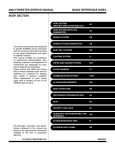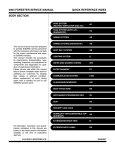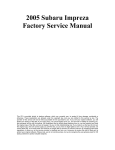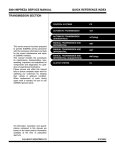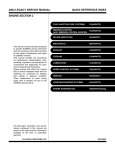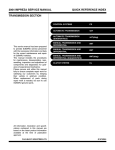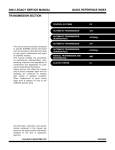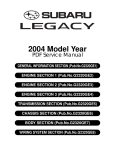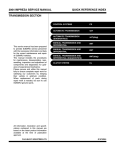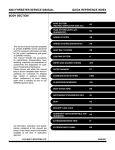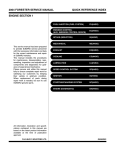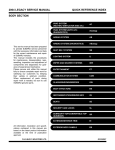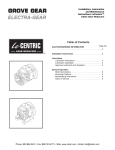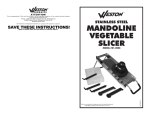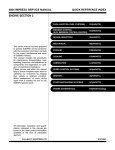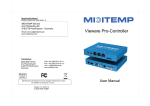Download Starting Charging System
Transcript
2004 IMPREZA SERVICE MANUAL QUICK REFERENCE INDEX ENGINE SECTION 1 This service manual has been prepared to provide SUBARU service personnel with the necessary information and data for the correct maintenance and repair of SUBARU vehicles. This manual includes the procedures for maintenance, disassembling, reassembling, inspection and adjustment of components and diagnostics for guidance of experienced mechanics. Please peruse and utilize this manual fully to ensure complete repair work for satisfying our customers by keeping their vehicle in optimum condition. When replacement of parts during repair work is needed, be sure to use SUBARU genuine parts. All information, illustration and specifications contained in this manual are based on the latest product information available at the time of publication approval. FUJI HEAVY INDUSTRIES LTD. FUEL INJECTION (FUEL SYSTEMS) FU(H4SO) EMISSION CONTROL (AUX. EMISSION CONTROL DEVICES) EC(H4SO) INTAKE (INDUCTION) IN(H4SO) MECHANICAL ME(H4SO) EXHAUST EX(H4SO) COOLING CO(H4SO) LUBRICATION LU(H4SO) SPEED CONTROL SYSTEMS SP(H4SO) IGNITION IG(H4SO) STARTING/CHARGING SYSTEMS SC(H4SO) ENGINE (DIAGNOSTICS) EN(H4SO)(diag) FUEL INJECTION (FUEL SYSTEMS) FU(H4SOw/oOBD) EMISSION CONTROL (AUX. EMISSION CONTROL DEVICES) EC(H4SOw/oOBD) INTAKE (INDUCTION) IN(H4SOw/oOBD) MECHANICAL ME(H4SOw/oOBD) EXHAUST EX(H4SOw/oOBD) COOLING CO(H4SOw/oOBD) G1870GE2 2004 IMPREZA SERVICE MANUAL QUICK REFERENCE INDEX ENGINE SECTION 1 LUBRICATION LU(H4SOw/oOBD) SPEED CONTROL SYSTEMS SP(H4SOw/oOBD) IGNITION IG(H4SOw/oOBD) STARTING/CHARGING SYSTEMS SC(H4SOw/oOBD) ENGINE (DIAGNOSTICS) EN(H4SOw/oOBD) (diag) G1870GE2 STARTING/CHARGING SYSTEMS SC(H4SO) 1. 2. 3. 4. Page General Description ....................................................................................2 Starter .........................................................................................................7 Generator ..................................................................................................13 Battery.......................................................................................................19 General Description STARTING/CHARGING SYSTEMS 1. General Description A: SPECIFICATIONS 1. NON-TURBO MODEL Starter Item Type Vehicle type Model Manufacturer Voltage and output Direction of rotation Number of pinion teeth Voltage No-load characCurrent teristics Rotating speed Voltage Current Load characteristics Torque Lock characteristics Rotating speed Voltage Current Torque Type Generator Model Manufacturer Voltage and output Polarity on ground side Direction of rotation Armature connection Output current Regulated voltage Battery Europe and Type and capac- South America ity Others Designation Reduction type MT 1.6 L AT 2.0 L AT, 2.5 L AT M000T30471 M000T30571 M000T20171 Mitsubishi Electric 12 V — 1.0 kW 12 V — 1.4 kW Counterclockwise (when observed from pinion) 8 9 11 V 95 A or less 90 A or less 2,500 rpm or more 2,000 rpm or more 7.5 V 7.7 V 300 A 400 A 8.84 N·m (0.90 kgf-m, 6.5 ft-lb) or 16.7 N·m (1.70 kgf-m, 12.3 ft-lb) or more more 870 rpm or more 710 rpm or more 4V 3.5 V 680 A or less 960 A or less 17 N·m (1.73 kgf-m, 12.5 ft-lb) or 31 N·m (3.16 kgf-m, 22.9 ft-lb) or more more Rotating-field three-phase, voltage regulator built-in type, with load response control system A2TB5391, A2TB6291* Mitsubishi Electric 12 V — 75 A Negative Clockwise (when observed from pulley side) Three-phase Y-type 1,500 rpm — 30 A or more 2,500 rpm — 64 A or more 5,000 rpm — 76 A or more 14.1 — 14.8 V [20°C (68°F)] 1.6 L: 12 V — 48 AH (55D 23L) 12 V — 48 AH (55D 23L) 2.0 L: 12 V — 52 AH (65D 23L) 2.5 L: 12 V — 52 AH (75D 23L) 12 V — 27 AH (34D 19L) *: For Australia and general SC(H4SO)-2 General Description STARTING/CHARGING SYSTEMS 2. TURBO MODEL Starter Item Type Vehicle type Model Manufacturer Voltage and output Direction of rotation Number of pinion teeth Voltage No-load characCurrent teristics Rotating speed Voltage Current Load characteristics Torque Lock characteristics Rotating speed Voltage Current Torque Type Generator Model Manufacturer Voltage and output Polarity on ground side Direction of rotation Armature connection Output current Regulated voltage Battery Europe and Type and capac- South America ity Australia Designation Reduction type MT AT 228000 — 9270 M001T20171 DENSO Mitsubishi Electric 12 V — 1.0 kW 12 V — 1.4 kW Counterclockwise (when observed from pinion) 9 11.5 V 11 V 90 A or less 3,000 rpm or more 2,000 rpm or more 8V 7.7 V 280 A 400 A 16.7 N·m (1.70 kgf-m, 12.3 ft-lb) or 9.3 N·m (0.95 kgf-m, 6.9 ft-lb) or more more 860 rpm or more 710 rpm or more 5V 3.5 V 515 A or less 960 A or less 16 N·m (1.63 kgf-m, 11.8 ft-lb) or 31 N·m (3.16 kgf-m, 22.9 ft-lb) or more more Rotating-field three-phase, voltage regulator built-in type, with load response control system A2TB5391, A2TB6291* Mitsubishi Electric 12 V — 75 A Negative Clockwise (when observed from pulley side) Three-phase Y-type 1,500 rpm — 30 A or more 2,500 rpm — 64 A or more 5,000 rpm — 76 A or more 14.1 — 14.8 V [20°C (68°F)] 12 V — 48 AH (55D 23L) 12 V — 52 AH (65D 23L) 12 V— 40 AH (50D 20L) *: For Australia and South America (except STi) SC(H4SO)-3 General Description STARTING/CHARGING SYSTEMS B: COMPONENT 1. STARTER • EXCEPT FOR DOHC TURBO MT MODEL (1) (4) (10) (9) (3) (2) (8) (7) (6) (5) (16) (12) (11) (14) (15) (13) SC-02009 (1) (2) (3) (4) (5) (6) Front bracket Sleeve bearing Lever set Magnet switch ASSY Stopper set Overrunning clutch (7) (8) (9) (10) (11) (12) Internal gear ASSY Shaft ASSY Gear ASSY Packing Yoke ASSY Armature SC(H4SO)-4 (13) (14) (15) (16) Brush holder ASSY Sleeve bearing Rear cover Rear cover set General Description STARTING/CHARGING SYSTEMS • DOHC TURBO MT MODEL (4) (2) (11) (10) (9) (3) (8) (1) (7) (6) (17) (5) (16) (15) (14) (13) (12) SC-00168 (1) (2) (3) (4) (5) (6) Sleeve bearing Front bracket Lever set Magnet switch ASSY Stopper set Overrunning clutch (7) (8) (9) (10) (11) (12) Internal gear ASSY Shaft ASSY Gear ASSY Ball Packing Yoke ASSY SC(H4SO)-5 (13) (14) (15) (16) (17) Armature Brush holder ASSY Brush Sleeve bearing Rear cover General Description STARTING/CHARGING SYSTEMS 2. GENERATOR (5) (6) (4) (2) (3) (1) (12) (11) (10) (9) (8) (7) SC-00144 (1) (2) (3) (4) Pulley Front cover Ball bearing Bearing retainer (5) (6) (7) (8) Rotor Bearing Stator coil IC regulator with brush C: CAUTION • Wear working clothing, including a cap, protective goggles and protective shoes during operation. • Remove contamination including dirt and corrosion before removal, installation or disassembly. • Keep the disassembled parts in order and protect them from dust or dirt. • Before removal, installation or disassembly, be sure to clarify the failure. Avoid unnecessary removal, installation, disassembly, and replacement. (9) (10) (11) (12) Brush Rectifier Rear cover Terminal • Be careful not to burn your hands, because each part on the vehicle is hot after running. • Be sure to tighten fasteners including bolts and nuts to the specified torque. • Place shop jacks or rigid racks at the specified points. • Before disconnecting electrical connectors of sensors or units, be sure to disconnect the ground cable from battery. SC(H4SO)-6 Starter STARTING/CHARGING SYSTEMS 2. Starter 5) Disconnect the connector and terminal from starter. A: REMOVAL 1) Disconnect the ground cable from battery. SC-00006 (A) Terminal (B) Connector FU-00009 2) Remove the air cleaner case. (Non-turbo model) <Ref. to IN(H4SO)-5, REMOVAL, Air Cleaner Case.> 3) Remove the intercooler. (Turbo model) <Ref. to IN(H4DOTC)-10, REMOVAL, Intercooler.> 4) Remove the air cleaner case stay. (Non-turbo model) • MT MODEL 6) Remove the starter from transmission. SC-00007 B: INSTALLATION Install in the reverse order of removal. Tightening torque: 50 N·m (5.1 kgf-m, 37 ft-lb) SC-00004 • AT MODEL SC-00007 C: DISASSEMBLY SC-00005 1. STARTER ASSEMBLY 1) Loosen the nut which holds the terminal M of switch assembly, and then disconnect the connector. 2) Remove the bolts which hold the switch assembly, and then remove switch assembly, plunger and plunger spring from starter as a unit. SC(H4SO)-7 Starter STARTING/CHARGING SYSTEMS NOTE: Be careful because the pinion gap adjustment washer may sometimes be used on the mounting surface of switch assembly. NOTE: Before removal of the yoke, put alignment marks on the yoke and front bracket. (B) (D) (A) (C) SC-00171 (B) (A) SC-00169 (A) (B) (C) (D) (A) Switch ASSY (B) Plunger 3) Remove both through-bolts and brush holder screws, and then detach the rear cover and brush holder. (A) Front bracket Yoke Ball Armature 5) Remove packing A, planetary gears, packing B and plate. (B) (B) (A) (C) (D) SC-00170 SC-00172 (A) Brush holder (B) Rear cover 4) Remove the armature and yoke from front bracket. The ball used as a bearing will come off from the armature end. (A) (B) (C) (D) Packing A Planetary gear Plate Packing B 6) Remove the shaft assembly and overrunning clutch as a unit. SC(H4SO)-8 Starter STARTING/CHARGING SYSTEMS NOTE: Note the direction of the lever before removing. (C) 2. BRUSH HOLDER NOTE: Only the brush holder of turbo MT model starter can be disassembled. Slightly open the metal fitting while holding the insulating plate against the brush holder. Remove the insulating plate. The brush and spring can be easily removed from the brush holder at this time. (A) (B) SC-00173 (B) (A) Shaft ASSY (B) Overrunning clutch (C) Lever (A) 7) Remove the overrunning clutch from shaft assembly as follows: (1) Remove the stopper from ring by lightly tapping the stopper with an appropriate tool (such as a fit socket wrench). (2) Remove the ring, stopper and clutch from shaft. (C) SC-00174 (A) Brush holder (B) Insulating plate (C) Metal fitting D: ASSEMBLY 1) Assemble in the reverse order of disassembly. 2) Apply grease to the following parts before assembly. • Front and rear bracket sleeve bearings • Armature shaft gear • Outer periphery of plunger • Mating surfaces of plunger and lever • Gear shaft splines • Mating surfaces of lever and clutch • Ball at armature shaft end • Planetary gear E: INSPECTION 1. ARMATURE SC-00014 (A) (B) (C) (D) 1) Check the commutator for any sign of burns of rough surfaces or stepped wear. If wear is of a minor nature, correct it by using sand paper. 2) Run-out test Check the commutator run-out, and then replace if it exceeds the limit. Socket wrench Ring Shaft Stopper SC(H4SO)-9 Starter STARTING/CHARGING SYSTEMS Commutator run-out: Standard 0.05 mm (0.0020 in) Service limit Less than 0.10 mm (0.0039 in) 4) Armature short-circuit test Check the armature for short-circuit by placing it on a growler tester. Hold an iron sheet against the armature core while slowly rotating armature. A short-circuited armature will cause the iron sheet to vibrate and to be attracted to core. If the iron sheet is attracted or vibrates, the armature, which is short-circuited, must be replaced or repaired. (A) (B) SC-00021 (A) Dial gauge (B) V-block SC-00023 3) Depth of segment mold Check the depth of segment mold. (A) Iron sheet (B) Grower tester Depth of segment mold: 0.5 mm (0.020 in) 5) Armature ground test Using a circuit tester, touch one probe to the commutator segment and the other to shaft. There should be no continuity. If there is continuity, the armature is grounded. Replace the armature if it is grounded. (B) (C) (A) SC-00022 (A) Depth of mold (B) Segment (C) Mold SC-00024 2. YOKE Make sure the pole is set in position. 3. OVERRUNNING CLUTCH Inspect the teeth of pinion for wear and damage. Replace if it is damaged. It is normal if the pinion rotates smoothly in direction of rotation (counterclockwise) and does not rotate in the opposite direction. CAUTION: Do not clean the overrunning clutch with oil to prevent grease from flowing out. SC(H4SO)-10 Starter STARTING/CHARGING SYSTEMS 4. BRUSH AND BRUSH HOLDER 1) Brush length Measure the brush length, and then replace if it is worn down to under the service limit. Replace if abnormal wear or cracks are noticed. Terminal/Specified resistance: S — M/Less than 1 Ω S — Ground/Less than 1Ω M — B/More than 1 MΩ Brush length: Standard 12.3 mm (0.484 in) Service limit 7.0 mm (0.276 in) B S M SC-00075 6. SWITCH ASSEMBLY OPERATION 1) Connect the terminal S of switch assembly to positive terminal of battery with a lead wire, and starter body to ground terminal of battery. The pinion should be forced endwise on shaft. (A) (B) SC-00102 (A) Service limit line (B) Brush 2) Brush movement Be sure the brush moves smoothly inside brush holder. 3) Brush spring force Measure the brush spring force with a spring scale. If it is less than the service limit, replace the brush holder. Brush spring force: CAUTION: With the pinion forced endwise on shaft, the starter motor may rotate because current flows through the pull-in coil to motor, however, this is not a problem. 2) Disconnect the connector from terminal M, and then connect the positive terminal of battery and terminal M using a lead wire and ground terminal to starter body. In this test set up, the pinion should return to its original position even when it is pulled out with a screwdriver. Standard Except DOHC turbo MT model 15.9 — 19.5 N (1.62 — 1.99 kgf, 3.57 — 4.38 lb) (when new) DOHC turbo MT model 21.6 N (2.2 kgf, 4.9 lb) (when new) Service limit Except DOHC turbo MT model 2.5 N (0.25 kgf, 0.56 lb) DOHC turbo MT model 5.9 N (0.6 kgf, 1.3 lb) (B) (A) SC-00175 (A) Terminal S (B) Terminal M 5. SWITCH ASSEMBLY Using a circuit tester (set in “ohm”), check that there is continuity between terminals S and M, and between terminal S and ground. Also check to be sure there is no continuity between terminals M and B. SC(H4SO)-11 Starter STARTING/CHARGING SYSTEMS 7. PERFORMANCE TEST The starter should be submitted to performance tests whenever it has been overhauled, to assure its satisfactory performance when installed on the engine. Three performance tests, no-load test, load test, and lock test, are presented here; however, if the load test and lock test cannot be performed, carry out at least the no-load test. For these performance tests, use the circuit shown in figure. S B (B) (A) M + (C) 12V V A SC-00077 (A) Variable resistor (B) Magnetic switch (C) Starter body 1) No-load test With switch on, adjust the variable resistor to obtain 11 V, take the ammeter reading, and then measure the starter speed. Compare these values with the specifications. No-load test (standards): Voltage/Current 1.6L MT, 2.0L Non-turbo MT, 2.5L MT and 1.6L AT MAX. 11 V/95 A 2.0L Non-turbo AT, 2.5L AT MAX. 11 V/90 A 2.0L Turbo MAX. 11 V/90 A Rotating speed 1.6L MT, 2.0L Non-turbo MT, 2.5L MT and 1.6L AT More than 2,500 rpm 2.0L Non-turbo AT, 2.5L AT More than 2,000 rpm 2.0L Turbo MT More than 3,000 rpm 2.0L Turbo AT More than 2,000 rpm 2) Load test Apply the specified braking torque to starter. The condition is satisfactory if the current draw and starter speed are within the specifications. Load test (standards): Voltage/Load 1.6L MT, 2.0L Non-turbo MT, 2.5L MT and 1.6L AT 7.5 V/8.84 N·m (0.90 kgf-m, 6.5 ft-lb) 2.0L Non-turbo AT, 2.5L AT 7.7 V/16.7 N·m (1.70 kgf-m, 12.3 ft-lb) 2.0L Turbo MT 8 V/9.3 N·m (0.95 kgf-m, 6.9 ft-lb) 2.0L Turbo AT 7.7 V/16.7 N·m (1.70 kgf-m, 12.3 ft-lb) Current/Speed 1.6L MT, 2.0L Non-turbo MT, 2.5L MT and 1.6L AT More than 300 A/870 rpm 2.0L Non-turbo AT, 2.5L AT More than 400 A/710 rpm 2.0L Turbo MT More than 280 A/860 rpm 2.0L Turbo AT More than 400 A/710 rpm 3) Lock test With the starter stalled, or not rotating, measure the torque developed and current draw when the voltage is adjusted to the specified voltage. Lock test (standards): Voltage/Current 1.6L MT, 2.0L Non-turbo MT, 2.5L MT and 1.6L AT Less than 4 V/680 A 2.0L Non-turbo AT, 2.5L AT Less than 3.5 V/960 A 2.0L Turbo MT Less than 5 V/515 A 2.0L Turbo AT Less than 3.5 V/960 A Torque 1.6L MT, 2.0L Non-turbo MT, 2.5L MT and 1.6L AT 17 N·m (1.73 kgf-m, 12.5 ft-lb) 2.0L Non-turbo AT, 2.5L AT 31 N·m (3.16 kgf-m, 22.9 ft-lb) 2.0L Turbo MT 16 N·m (1.63 kgf-m, 11.8 ft-lb) 2.0L Turbo AT 31 N·m (3.16 kgf-m, 22.9 ft-lb) SC(H4SO)-12 Generator STARTING/CHARGING SYSTEMS 3. Generator 5) Remove the bolts which install generator onto bracket. A: REMOVAL 1) Disconnect the ground cable from battery. SC-00032 FU-00009 2) Disconnect the connector and terminal from generator. • NON-TURBO MODEL B: INSTALLATION Install in the reverse order of removal. Tightening torque: 25 N·m (2.5 kgf-m, 18.1 ft-lb) CAUTION: Check and adjust the V-belt tension. <Ref. to ME(H4SO)-44, INSPECTION, V-belt.> or <Ref. to ME(H4DOTC)-55, INSPECTION, V-belt.> SC-00029 • TURBO MODEL SC-00032 C: DISASSEMBLY 1) Remove the four through-bolts. SC-00143 3) Remove the V-belt cover. 4) Remove the front side V-belt. <Ref. to ME(H4SO)-43, FRONT SIDE BELT, REMOVAL, V-belt.> or <Ref. to ME(H4DOTC)-54, FRONT SIDE BELT, REMOVAL, V-belt.> SC(H4SO)-13 SC-00078 Generator STARTING/CHARGING SYSTEMS 2) Heat portion (A) of rear cover to 50°C (122°F) with a heater drier. (A) CAUTION: When holding the rotor with a vise, place aluminum plates or wooden pieces on the vise jaws to prevent rotor from damage. (A) (B) SC-00079 (C) 3) Then insert the tip of a flat tip screwdriver into the gap between stator core and front cover. Pry them apart to disassemble. (D) (A) (B) (C) (D) SC-00036 Front cover Pulley Nut Rotor 5) Remove the ball bearing as follows. (1) Remove the bolt, and then remove the bearing retainer. (A) (A) SC-00080 (A) Screwdriver 4) Hold the rotor with a vise and remove pulley nut. SC-00081 (2) Firmly install an appropriate tool (such as a fit socket wrench) to bearing inner race. SC-00035 SC-00082 (3) Push the ball bearing off the front cover using a press. SC(H4SO)-14 Generator STARTING/CHARGING SYSTEMS 6) Remove the bearing from rotor using a bearing puller. (2) Unsolder the connection between IC regulator and rectifier to remove the IC regulator. SC-00046 7) Unsolder connection between rectifier and stator coil to remove the stator coil. SC-00085 9) Remove the brush as follows. (1) Remove cover A. CAUTION: Do not allow a 180 — 270 W soldering iron to contact the terminals for more than 5 seconds at once because the rectifier cannot withstand so much heat. (A) SC-00086 (A) Cover A (2) Remove cover B. SC-00083 (A) 8) Remove the IC regulator as follows. (1) Remove the screws which secure IC regulator to rear cover. SC-00087 (A) Cover B SC-00084 (3) Separate the brush from connection to remove. SC-00088 SC(H4SO)-15 Generator STARTING/CHARGING SYSTEMS 10) Remove the rectifier as follows. (1) Remove the bolts which secure the rectifier. CAUTION: Be sure to remove the wire after reassembly. (A) SC-00089 SC-00092 (2) Remove the cover of terminal B. (A) Wire SC-00090 (3) Remove the nut of terminal B, and then remove the rectifier. 2) Install the ball bearing. (1) Set the ball bearing on the front cover, and then securely install an appropriate tool (such as a fit socket wrench) to the bearing outer race. (2) Press the ball bearing into the specified position using a press. (3) Install the bearing retainer. 3) Press the bearing (rear side) into the rotor shaft using a press to install. 4) Heat the bearing box in rear cover [50 to 60°C (122 to 140°F)], and then press the rear bearing into rear cover. CAUTION: Grease should not be applied to rear bearing. Remove the oil completely if it is found on bearing box. 5) After reassembly, turn the pulley by hand to check that rotor turns smoothly. E: INSPECTION 1. DIODE SC-00091 D: ASSEMBLY Assemble in the reverse order of disassembly. 1) Pulling up brush Before assembling, press the brush down into brush holder, and then fix them in that position by passing a [1 mm (0.08 in) dia. 40 to 50 mm (1.6 to 2.0 in) long] wire through the hole as shown in the figure. CAUTION: Never use a mega tester (designed for reading high voltage) or any other similar instrument for this test; otherwise, the diodes may be damaged. SC(H4SO)-16 Generator STARTING/CHARGING SYSTEMS 1) Checking positive diode Check for continuity between the diode lead and positive side heat sink. The positive diode is in good condition if resistance is 1 Ω or less only in the direction from the diode lead to heat sink. (A) If the resistance is not within the specified range, replace the rotor assembly. Specified resistance: Approx. 1.8 — 2.2 Ω (B) SC-00044 SC-00042 (A) Diode lead (B) Heat sink (positive side) 2) Checking negative diode Check for continuity between the negative side heat sink and diode lead. The negative diode is in good condition if resistance is 1 Ω or less only in the direction from the heat sink to diode lead. 4) Insulation test Check the continuity between slip ring and rotor core or shaft. If resistance is 1 Ω or less, the rotor coil is grounded, and so replace the rotor assembly. (A) (B) SC-00045 SC-00043 5) Ball bearing (rear side) Check the rear ball bearing. Replace if it is noisy or if the rotor does not turn smoothly. 3. STATOR (A) Diode lead (B) Heat sink (negative side) 2. ROTOR 1) Slip ring surface Inspect the slip rings for contamination or any roughness on the sliding surface. Repair the slip ring surface using a lathe or sand paper. 2) Slip ring outer diameter Measure the slip ring outer diameter. If the slip ring is worn, replace the rotor assembly. 1) Continuity test Inspect the stator coil for continuity between each end of the lead wires. If resistance is 1 MΩ or more, the lead wire is broken, and so replace the stator assembly. Slip ring outer diameter: Standard 22.7 mm (0.894 in) Limit 22.1 mm (0.870 in) 3) Continuity test Check the resistance between slip rings using circuit tester. SC(H4SO)-17 (A) SC-00047 (A) Stator Generator STARTING/CHARGING SYSTEMS 2) Insulation test Inspect the stator coil for continuity between stator core and each end of lead wire. If resistance is 1 Ω or less, the stator coil is grounded, and so replace the stator assembly. 2) Checking brush spring for proper pressure Using a spring pressure indicator, push the brush into the brush holder until its tip protrudes 2 mm (0.08 in). Then measure the pressure of brush spring. If the pressure is less than 2.648 N (270 g, 9.52 oz), replace the brush spring with a new one. The new spring must have a pressure of 4.609 to 5.786 N (470 to 590 g, 16.58 to 20.810 oz). SC-00048 4. BRUSH 1) Measure the length of each brush. If wear exceeds the service limit, replace the brush. Each brush has the service limit mark (A) on it. SC-00093 5. BEARING (FRONT SIDE) Check the front ball bearing. If the resistance is felt while rotating, or if abnormal noise is heard, replace the ball bearing. 5.0 (0.197) Brush length: Standard 18.5 mm (0.728 in) Service limit 5.0 mm (0.197 in) 13.5 (0.531) (A) SC-00049 SC(H4SO)-18 Battery STARTING/CHARGING SYSTEMS 4. Battery 1. EXTERNAL PARTS: A: REMOVAL Check for the existence of dirt or cracks on battery case, top cover, vent plugs, and terminal posts. If necessary, clean with water and wipe with a dry cloth. Apply a thin coat of grease on the terminal posts to prevent corrosion. 1) Disconnect the positive (+) cable after disconnecting the ground (−) cable of battery. 2) Remove the flange nuts from battery rods, and then take off the battery holder. 2. ELECTROLYTE LEVEL: Check the electrolyte level in each cell. If the level is below MIN LEVEL, bring the level to MAX LEVEL by pouring distilled water into the battery cell. Do not fill beyond MAX LEVEL. 3. SPECIFIC GRAVITY OF ELECTROLYTE: 3) Remove the battery. B: INSTALLATION Install in the reverse order of removal. Tightening torque: 3.4 N·m (0.35 kgf-m, 2.5 ft-lb) NOTE: • Clean the battery cable terminals, and then apply grease to retard formation of corrosion. • Connect the positive (+) cable of battery and then the ground (−) cable of battery. C: INSPECTION WARNING: • Electrolyte has toxicity; be careful handling the fluid. • Avoid contact with skin, eyes or clothing. Especially at contact with eyes, flush with running water for 15 minutes and get prompt medical attention. • Batteries produce explosive gasses. Keep sparks, flame, cigarettes away. • Ventilate when charging or using in enclosed space. • For safety, in case an explosion does occur, wear eye protection or shield your eyes when working near any battery. Never lean over a battery. • Do not let the battery fluid contact eyes, skin, fabrics, or paint-work because battery fluid is corrosive acid. • To lessen the risk of sparks, remove rings, metal watch-bands, and other metal jewelry. Never allow metal tools to contact the positive battery terminal and anything connected to it while you are at the same time in contact with any other metallic portion of the vehicle. This may cause a short circuit. S20 = St + 0.0007 × (t − 20) S20: Specific gravity corrected at electrolyte temperature of 20°C St: Measured specific gravity t: Measured temperature (°C) Determine whether or not battery must be charged, according to corrected specific gravity. Standard specific gravity: 1.220 — 1.290 [at 20°C (68°F)] Specific gravity [20˚C (68˚F)] SC-00053 1) Measure the specific gravity of electrolyte using a hydrometer and a thermometer. Specific gravity varies with temperature of electrolyte so that it must be corrected at 20°C (68°F) using the following equation: 1.28 1.26 1.24 1.22 1.20 1.18 1.16 1.14 1.12 100% 75% 50% 22% 0% Complete charge Charging condition (%) Specific gravity and state of charge SC-00094 2) Measuring the specific gravity of the electrolyte in battery will disclose the state of charge of battery. The relation between specific gravity and state of charge is as shown in the figure. D: MEASUREMENT WARNING: Do not bring an open flame close to the battery at this time. CAUTION: • Prior to charging, corroded terminals should be cleaned with a brush and common caustic soda solution. SC(H4SO)-19 Battery STARTING/CHARGING SYSTEMS • Be careful since the battery electrolyte overflows while charging the battery. • Observe the instructions when handling battery charger. • Before charging the battery on vehicle, disconnect battery ground terminal to prevent damage of generator diodes or other electrical units. 1. JUDGMENT OF BATTERY IN CHARGED CONDITION 1) Specific gravity of electrolyte is held within the specified range from 1.250 to 1.290 for more than one hour. 2) Voltage per battery cell is held at the specified range from 2.5 to 2.8 volts for more than one hour. 2. STATE OF CHARGE CHECK USING A HYDROMETER Hydrometer indicator Green dot Dark dot State of charge Corrective action Above 65% Below 65% Load test Charge battery Replace battery* Clear dot Low electrolyte (If cranking is difficult) *: Check electrical system before replacement. 3. NORMAL CHARGING Charge the battery at current value specified by manufacturer or at approx. 1/10 of the battery’s ampere-hour rating. 4. QUICK CHARGING Quick charging is a method in which the battery is charged in a short period of time with a relatively large current by using a quick charger. Since a large current flow raises electrolyte temperature, the battery is subject to damage if large current is used for prolonged time. For this reason, the quick charging must be carried out within a current range that will not increase the electrolyte temperature above 40°C (104°F). It should be also remembered that the quick charging is a temporary means to bring battery voltage up to a fair value and, as a rule, a battery should be charged slowly with a low current. CAUTION: • Observe the items in 3. NORMAL CHARGING. • Never use more than 10 amperes when charging the battery because that will shorten battery life. SC(H4SO)-20























